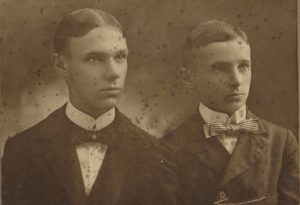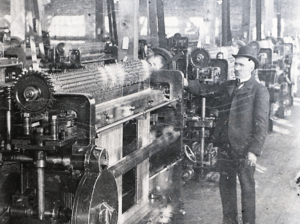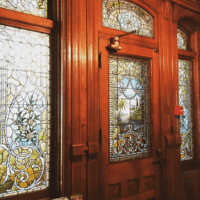1890 House Museum facts for kids
Quick facts for kids |
|
|
1890 House Museum
|
|
 |
|
| Location | 37 Tompkins St., Cortland, New York |
|---|---|
| Built | 1890 |
| Architect | Samuel B. Reed |
| Architectural style | Chateauesque |
| Website | the1890House.org |
| NRHP reference No. | 75001179 (original) 82001116 (increase) |
| Added to NRHP | March 18, 1975 (original) November 17, 1982 (increase) |
The 1890 House Museum is a cool historic house located on Tompkins Street in Cortland, New York. It was built in 1890 for a successful businessman named Chester F. Wickwire (1843–1910). The house was designed by the architect Samuel B. Reed. This grand home is a lot like another mansion built for a circus manager, James Anthony Bailey, in Harlem, New York City.
The beautiful stained glass windows throughout the house were made by Henry F. Belcher. Chester Wickwire lived in the house from 1890 until he died in 1910. He earned his money by starting and running the Wickwire Brothers Company in Cortland, NY. This company made many wire products, like screens for windows and tools for farms.
In 1974, the 1890 House Museum became part of the Tompkins Street District. This district was added to the National Register of Historic Places. Then, in 1975, the 1890 House officially opened as a museum. This happened after leaders in Cortland County worked hard to make it happen.
Contents
History of the 1890 House
The First Wickwire Family at Home
Meet the Wickwire Family
Chester Wickwire, his wife Ardell, and their sons Charles and Frederic moved into the house on June 1, 1890. After Chester passed away in 1910, Ardell Wickwire continued to live in the house until her death in 1915.
Chester was born in 1843. His family were farmers in McGrawville, NY, which is now called McGraw, New York. When Chester was 19, his family moved to Cortland. They opened a grocery store on Main Street. Chester and his father, Raymond, managed the store at first.
After Raymond passed away, Chester's brother Chauncey took over his father's duties. When Chauncey died at age 27, Chester's other brother, Theodore, helped out. They changed the store from a grocery store to a hardware store. Chester married Ardell Rouse on October 2, 1866. They had three children: Raymond, Charles, and Frederic. Sadly, Raymond died at age five from scarlet fever in 1878. His two younger brothers later joined their father in the family business.
Life of a Servant: Margaret Stack
Besides the Wickwire family, several servants also lived at the mansion. One servant was a 21-year-old Irish cook named Margaret Stack. She came from Athea, County Limerick, Ireland, in 1904. Margaret arrived in America at Ellis Island with two of her siblings.
Margaret Stack worked at the house from 1904 to 1911. After that, she moved back to Ireland with her husband, John Lane. He was also an Irish immigrant whom she met in Cortland. Today, visitors to the 1890 House Museum can see Margaret Stack's bedroom. They can also learn about what life was like for servants during the Victorian era.
The Second Wickwire Family Moves In
After Ardell's death in 1915, the house was empty for eight years. Then, Frederic, Chester's son, moved in with his wife Marian. Marian was a local poet. Frederic and Marian updated the house. They added new styles and decorations that were popular in the 1920s.
Frederic died in 1929. Marian later married a local judge named C. Leonard O’Connor. Marian Goodrich Wickwire O’Connor lived in the house until 1973. She also outlived her second husband.
The Wickwire Brothers Factory
In 1873, Chester Wickwire received a carpet loom as part of a trade at his hardware store. He was very clever and changed the loom to weave wire instead of carpet. By doing this, he found a cheaper way to make wire products. After their store on Main Street in Cortland became too small, Chester and his brother, Theodore, opened their own factory. They called it the Wickwire Brothers Company.
By 1883, their company had become the second largest maker of wire goods in the United States. This success was partly thanks to Chester's special inventions and patents. The Wickwires hired many immigrants to work in their factory. These workers mainly came from Germany, Italy, Ukraine, Russia, and Ireland.
The employees worked on an assembly line, which could be dangerous. Even though Chester was known as a fair and well-liked factory owner, the factory did have some tough times. There were seven industrial accidents between 1887 and 1897. For example, in February 1888, a 14-year-old boy lost his toes and part of his foot. In April 1888, one man's fingers were badly hurt in the gears of a loom.
The 1890 House Museum Today
The museum offers both guided tours and self-guided tours for visitors. You can explore several rooms on three floors. You can also see the cupola, which is a small dome-like structure on the roof.
The 1890 House Museum also has monthly educational programs and special events. They even have a YouTube series called WickWired. This series teaches you about the Victorian age and the lives of the Wickwire Family.
Gallery
See also
- Tompkins Street–Main Street Historic District







